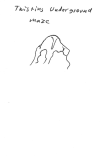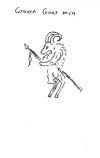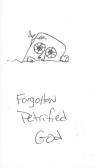 1000 Blank White Cards is a fun game on it’s own, but it’s also a tool that can be twisted to any number of uses. Here’s just one way to make it’s creative synergy and frenetic energy work for you: use it to design your campaign world. Like other collaborative world building methods, this system allows your entire group to have input into your campaign world. It also takes advantage of the creativity and synergy of your entire group.
1000 Blank White Cards is a fun game on it’s own, but it’s also a tool that can be twisted to any number of uses. Here’s just one way to make it’s creative synergy and frenetic energy work for you: use it to design your campaign world. Like other collaborative world building methods, this system allows your entire group to have input into your campaign world. It also takes advantage of the creativity and synergy of your entire group.
Start with a rough understanding of what you’re creating (game system, genre, etc…) so that everyone is on the same page and then play 1KBWC. This variant uses only three types of cards: Locations, Location Details, and World Details, all explained below, and requires a relatively sizable play area. Otherwise, it plays much like the original game. If you’re not familiar with the rules of 1KBWC, you can read them here.
 Location Cards:
Location Cards:
Location cards are the heart of this variant. They have the name of a location, a picture, and if necessary a short description or a few details written underneath. Resist the temptation, however to add more than a sentence or so. Part of the fun is allowing the locations to “grow organically”. These locations can be as macro or micro as you desire. Countries, forests, haunted houses, lakes, monster dens, and hidden chambers are all fair game.
 Location cards are played into a communal play area wherever you desire with their relative positions representing rough map locations (unlike the base game there is only one area and ownership is irrelevant). Thus if the “Ruined Hilltop Keep” is placed on the table to the right of the “Living Mountain”, The keep is roughly to the East of the mountain in the finished game world.
Location cards are played into a communal play area wherever you desire with their relative positions representing rough map locations (unlike the base game there is only one area and ownership is irrelevant). Thus if the “Ruined Hilltop Keep” is placed on the table to the right of the “Living Mountain”, The keep is roughly to the East of the mountain in the finished game world.

 Location cards can also be “nested” inside or outside of one another. If “Island on the back of a whale” is in play, another player can play “Twisting underground maze” as a sub-location of Island on the back of a whale (presumably the entrance is the whale’s blowhole) and another might play “ocean of madness”, making the whale island a sub location of the ocean. There’s no limit to how many sub locations a location can contain or how far you can “nest” locations aside from common sense. However, each location you nest within another is a location not on your map, so keep an idea of the right balance of quantity versus density of locations that you want.
Location cards can also be “nested” inside or outside of one another. If “Island on the back of a whale” is in play, another player can play “Twisting underground maze” as a sub-location of Island on the back of a whale (presumably the entrance is the whale’s blowhole) and another might play “ocean of madness”, making the whale island a sub location of the ocean. There’s no limit to how many sub locations a location can contain or how far you can “nest” locations aside from common sense. However, each location you nest within another is a location not on your map, so keep an idea of the right balance of quantity versus density of locations that you want.

 Location Details:
Location Details:
 Location Detail cards have an item, group, organization, individual or the like on them. Their purpose is to add some additional details to locations and populate your world. Like Location cards, they feature a name, a picture, and a short description. Location Detail cards can only be placed within locations and apply only to the location in which they are placed.
Location Detail cards have an item, group, organization, individual or the like on them. Their purpose is to add some additional details to locations and populate your world. Like Location cards, they feature a name, a picture, and a short description. Location Detail cards can only be placed within locations and apply only to the location in which they are placed.

 World Details:
World Details:
World Detail cards include details that pertain to the entire world. Gods, planes, details of the cosmos, histories, ubiquitous races, organizations, and technologies, hazards, and other world-spanning items belong on World Detail cards. These cards feature a name, picture, and some details. These cards are placed in a special area off to the side of the map. In general, the order these cards are played makes no difference, but if they represent past events, the order they’re played or arranged will form a sort of timeline for the world. Many Location Detail cards and World detail cards are interchangeable. A race card placed in a location appears only there. Placed in the world detail area, it is found throughout the entire world. Items, technologies, and other cards can be placed in either area similarly.

















This is a really neat idea. How far do you envision this taking worldgen after you’ve played it? Will a world created with this method be more-or-less ready to start creating characters, or is there a process of taking the “raw” world and refining it before the game starts, such as by maybe detailing some history? I imagine you can do both, but which would you recommend?
@Riklurt – That depends entirely on your group. In my imagination, the perfect scenario goes like this: If anyone in your group really cares about the world history (or any other detail types) they’ve made some cards for it and you at least have a rough skeleton for it already. If not, you probably can just wing one if it ever comes up. YMMV of course. It also depends on your comfort level with improvisation. If you can just fill in blanks on the fly with no issue, there’s a lot less cleanup necessary to play. System can be a factor too. Statting up new creations that your group has come up with can be done simply and easily in some systems and not so much in others (of course in those systems where it’s more difficult, you could ask that everyone stick to mostly material from established sources.)
What I really love about this system is that you can really use any facet of gaming in the same fashion. Have everyone at the table write down five villains, henchmen, treasures, goals, etc. Flip through them and sort them for an instant improv game or as a starter set of notes for a new campaign. Not only that, but my players love seeing their own ideas come back to haunt them.
This makes my little gnome stand at attention, Matt.
At first I was having trouble “closing the circle” and seeing how you’d use the minimal rules of 1KBWT to build a world, but now I see it and I think it’s brilliant.
It might be useful to have a bulletin board or something similar nearby, so that when an idea felt complete it could be pinned up in its present state so that the GM could record it later.
I really, really want to try this!
Any chance you can post a sample world created using this method? If not, I smell a possible contest idea — I’d love to see what GS readers do with this!